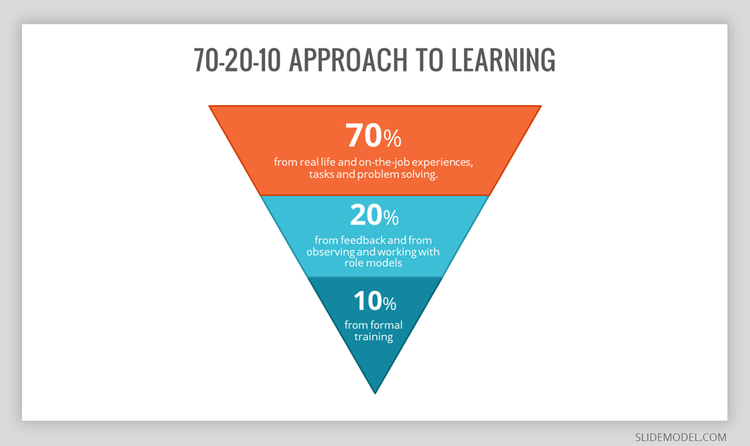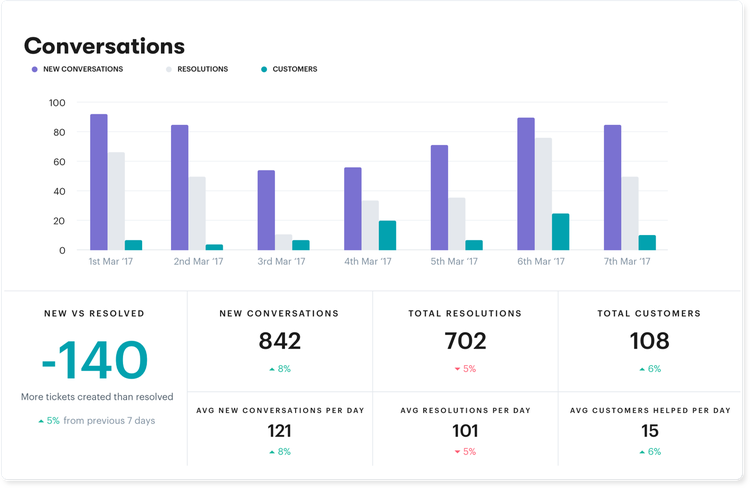Walmart founder Sam Walton said: “There is only one boss. The customer. And he can fire everybody in the company from the chairman on down, simply by spending his money somewhere else.”
Companies have traditionally focused on product price points and features to drive sales, but the customer service experience also has a significant impact. We'll go over a five-step process below to develop an effective customer service training program for your small business.
Why is customer service training important for small businesses?
Customer service training is critical because of the effect good customer service has on your bottom line:
- New customer acquisition costs up to five times more than retaining a current customer.
- You are up to 14 times more likely to make a sale to an existing customer than a new one.
- A 5% increase in customer retention can generate 25% to 95% more revenue.
These statistics highlight the importance of customer lifetime value (CLV), the total projected revenue generated by a single customer account. Increasing this number means customers are spending more money more often to purchase products and/or services from your business.
One way to maximize your CLV is to offer superior customer service instead of considering each sale as a one-and-done transaction.
Types of customer service
One-on-one interactions between customers and customer service representatives break into five categories:
- On-site
- Telephone
- Live online chat
- Social media
Customer self-service through methods such as help portals, knowledge bases, chatbots, and online forums and communities are also important, but here we'll focus on customer service staff training.
Types of customer service training
Use the 70-20-10 model when developing your customer service training program. This learning and development theory states 70% of training employees should be done on the job (OTJ), 20% through social interactions, and 10% from formal training.

The inverted 70-20-10 training pyramid reverses traditional expectations about how people learn. Image source: Author
The small amount of formal training may seem counterintuitive, but the 70-20-10 model, developed in the 1980s, emphasizes the role of the workplace to learn job skills.
Type 1: Formal training
Formal training may only account for 10% of skill acquisition, but it provides the framework for social and OTJ training to be successful. The two basic formal training methods are:
- Face-to-face: Instructor-led training is most common during employee onboarding and for teaching baseline skill sets. Other face-to-face learning opportunities include workshops, seminars, and group settings that allow participants to ask questions or answer questions from others.
- Online: Individual learning modules, webinars, and training videos allow employees to learn from anywhere on their own schedule. These methods are most effective when combined with periodic in-lesson assessments to verify knowledge acquisition.
Neither face-to-face nor online training is "better" than the other; instead, a thoughtful combination of the two creates multiple, overlapping opportunities for employees to learn and reinforce excellent customer service skills.
Type 2: Social training
Social training builds upon the skills and knowledge learned during formal training and emphasizes employee-based interactions at work. Methods include:
- Shadowing: Pair new hires with experienced employees to let them see how the job's nuts and bolts play out over the course of a day or more.
- Mentoring: Assign high-performing employees to regularly check on new hires in informal settings to learn what's going well, where they need help, and what questions they have.
- Online community: Create internal online forums, or even a dedicated Slack channel, for employees to ask and answer questions, relay other pertinent information, or offer kudos for jobs well done.
Social training integrates new employees with your existing workforce and demonstrates company culture in action.
Type 3: OTJ training
Ongoing experiential learning at work provides most of your employees' training. Methods to facilitate this include:
- Job aids: An online knowledge base, posters stating company policies and procedures, or even informational cheat sheets taped to the side of a computer monitor provide access to and reinforcement of critical information.
- Assessment: A job performance score -- A+, 85, satisfactory, or another type of grade -- based on supervisor evaluations and/or customer surveys.
- Feedback: Actionable advice to improve performance based on information contained in assessments.
Evaluations must help improve employees' future performance. They never work well when used negatively -- variations of "What were you thinking? Were you thinking?" -- because that creates an unhealthy workplace dynamic.
How to train your customer service team
Training your customer service team is not a one-time activity. Your products and services, company processes, and customer service software change over time. Training is a continuous improvement process (CIP) that requires ongoing effort and support.
Step 1: Establish your training program
Before training anyone to do anything, you must establish the parameters and makeup of your training program:
- Set goals: Define what you want your customer service training program to accomplish, and identify performance metrics to track results.
- Define critical skills: Identify the hard and soft skills customer service reps must have by the end of their formal training program -- these skills form the basis of your initial curriculum -- and follow-up social and OTJ training.
- Schedule training: Determine how long the initial formal training process should be and how, when, and where to conduct ongoing training.
- Choose teaching methods: Select instructional methods -- online, self-paced, webinar, one-on-one, group, formal, informal -- for each type of training.
Every training program incorporates multiple moving parts, and nobody gets it 100% correct right away. Solicit ongoing feedback from your trainees and trainers to determine what's working well and what needs improvement.
Step 2: Teach hard skills
Your formal training program provides the baseline knowledge customer service reps require to perform basic job tasks:
- Company products and services: Nothing is more maddening than talking to a customer service rep who can't answer basic questions about a company's offerings. Use a training manual with an established set of facts and specifications agents can refer to when talking to customers.
- Customer service software: Your reps must learn the basics of your customer service software. They'll learn the finer points through daily use, but like product specs, a minimum skill level is required before interacting with customers.
- Customer support processes: Your reps must also know your company's customer service processes, including how to take orders, issue refunds, handle returns, review and make changes to customer accounts, deal with complaints, and when to refer customers to a supervisor.
Formal training may constitute only 10% of the overall training process, but without this knowledge, the subsequent 90% of social and OTJ training will fail.
Step 3: Teach soft skills
Soft skills -- how to interact with customers -- are as important as hard skills. Extensive product knowledge and software abilities won't help support reps if they lack the emotional intelligence to help customers.
Every customer call, email, or other interaction presents a different situation to resolve. Essential abilities to do this include:
- Effective communication
- Active listening
- Conflict resolution
- Creative problem solving
- Negotiation skills
- Stress management
The rote memorization used to learn product features doesn't work with soft customer service skills. Instead, employ more one-on-one or group activities in formal, social, and OTJ settings. Useful methods include:
- Role playing: Use simulations and scenarios in team training with experienced reps and newbies, who assume various roles to work through different situations from multiple perspectives.
- Modeling: Mentoring and shadowing allow new reps to learn from their more experienced counterparts and see examples of good customer service.
- Debriefings: Once new reps are working with customers, periodically monitor their customer conversations, not only to assess their performance but to ask them how they felt about specific interactions and what they would do the same or differently.
The one overarching ability your customer service reps must have and develop is empathy: the ability to put themselves in their customers' shoes. Empathy transforms a potentially adversarial interaction into an opportunity for shared resolution.
Step 4: Implement continuous training
Change is a universal constant, so change or be a victim of change. Improving job performance is a CIP, which requires ongoing training in each learning model area:
- Formal: New products, features, services, company processes, assets, and customer service software updates
- Social: One-on-one and group interactions to answer questions, model positive behaviors, and discuss customer service incidents
- OJT: Job evaluations and performance awards
Remember the distinction between assessment and feedback -- and when it's appropriate to use each one -- because many people use the terms synonymously. Assessment is an empirical score based on current performance, and feedback is information to help improve performance.
Step 5: Measure performance
The final step in implementing your customer service training plan is measuring results. Performance metrics for your customer service department and individual agents include:
- Average help ticket first response time
- Percentage of tickets resolved with first response
- Average ticket resolution time
- Total ticket volume
- Customer satisfaction (CSAT) score
Other metrics include the cost-to-benefit ratio, customer churn, and product feedback.
Groove's customer service software report contains standard metrics for overall department performance: total customers, conversations (Groove's term for help tickets), resolutions, and daily breakdowns and averages.

This customer service department performance report contains the information necessary for actionable insights. Image source: Author
Once you establish an initial baseline, generate reports at regular intervals. This data for overall customer service department and individual agent performance provides the information necessary to maximize your customer support efforts.
Embrace customer service training for business success
Enduring success is an elusive target for most small businesses because 20% fail in their first year, 30% by the second year, and 70% by their tenth year. Leverage the financial impact superior customer service training can have on your bottom line to help your business succeed.
Our Small Business Expert
We're firm believers in the Golden Rule, which is why editorial opinions are ours alone and have not been previously reviewed, approved, or endorsed by included advertisers. The Ascent does not cover all offers on the market. Editorial content from The Ascent is separate from The Motley Fool editorial content and is created by a different analyst team.